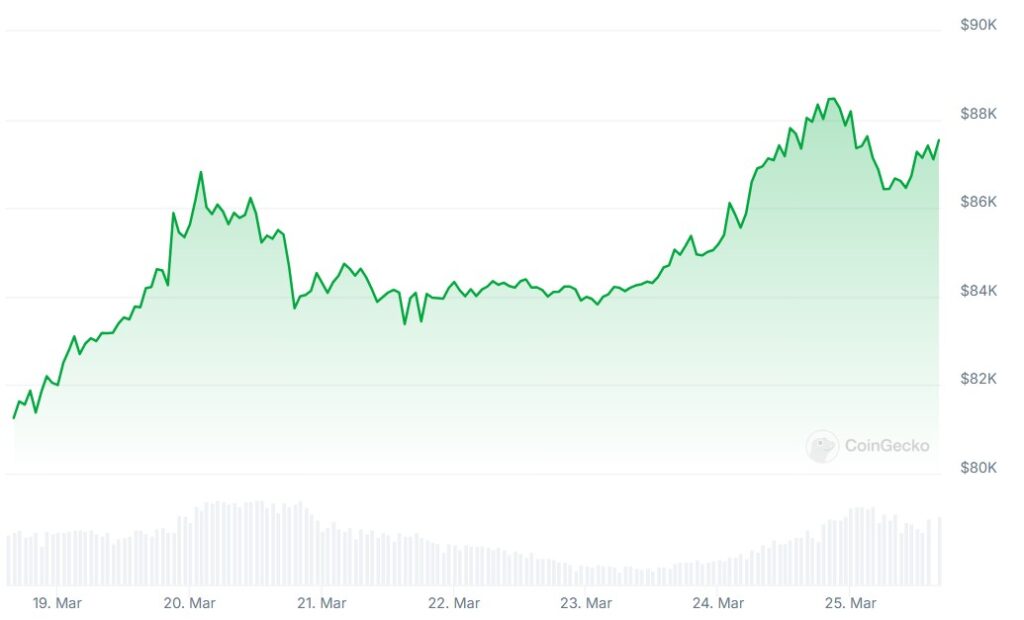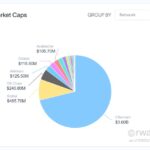Since January 20, 2023, the price of Bitcoin has experienced significant fluctuations, brought on by the tumultuous trade policies of the Biden administration. Bitcoin saw a peak of 9,000 but then fell below ,000, reflecting the broader instability caused by major tariff announcements from the U.S. and the responses from affected trade partners. Justin d’Anethan, head of sales at Liquifi, noted that the unpredictable nature of these trade talks has created a sense of uncertainty in the market, with many investors caught between fear of missing out on potential upswings and the reluctance to sell amidst ongoing volatility.
The situation intensified in late January when President Trump issued a stern threat of 25% tariffs on all Colombian imports, shortly followed by a backlash from Colombia that included their own tariffs. This back-and-forth initially contributed to Bitcoin’s decline, but the cryptocurrency regained momentum once Colombia agreed to accept deported migrants, easing tensions. However, another wave of concerns emerged with the rise of the Chinese AI firm DeepSeek, which sparked fears of disruption in tech ecosystems, further unsettling investors.
As February rolled in, Trump escalated trade tensions by enforcing additional tariffs on imports from China, Canada, and Mexico. Bitcoin dipped below the ,000 mark, only recovering temporarily during a brief pause in tariff enforcement from Trump. Yet, the fallout from a massive .4 billion hack of the crypto exchange Bybit underscored the fragility of the market, propelling Bitcoin’s value into the lower ,000s.
March brought a mixed bag of developments. Initially, Bitcoin hovered around ,000 as the economic landscape shifted due to a barrage of executive orders and tariff reviews from the White House. Investors saw signs of recovery, particularly when plans emerged for a Strategic Bitcoin Reserve that would diversify into various digital assets. However, a new wave of tariffs loomed with “Liberation Day” set for April 2, injecting fresh uncertainty into the market.
With fluctuating messaging from the administration leading to market jitters, traders are preparing for the impact of forthcoming tariffs on the economy. Analysts like Ryan Lee emphasize the potential for volatility, which could lead to inflationary pressures and wider economic disruptions following the implementation of these tariffs. As investors navigate this precarious landscape, the relationship between Bitcoin and traditional financial markets becomes increasingly integral, with many calling for vigilance as the situation continues to evolve.
Impact of US Trade Policies on Bitcoin and Global Markets
The fluctuating dynamics of US trade policies under President Trump have significantly influenced Bitcoin’s market value and investor sentiment. Here are the key points to consider:
- Bitcoin Volatility:
- Bitcoin reached a record high of 9,000 before dropping below ,000, highlighting its susceptibility to external economic factors.
- Significant price swings often correlated with tariff announcements and geopolitical tensions.
- Market Reactions to Trade Announcements:
- The threat of tariffs on Colombian imports led to a temporary dip in Bitcoin’s value, which indicated the cryptocurrency’s vulnerability to political events.
- Executive orders imposing tariffs on China, Canada, and Mexico caused Bitcoin to fall below ,000, showing how trade wars directly impact market sentiment.
- Dangers of External Disruptions:
- The rise of companies like DeepSeek created additional market uncertainty, emphasizing the need for investors to stay informed about technological disruptions.
- .4 billion hack of Bybit illustrated security vulnerabilities within the crypto space that can lead to drastic declines in market value.
- Future Economic Predictions:
- Upcoming tariff measures, dubbed “Liberation Day,” could lead to inflation spikes and supply chain disruptions, directly affecting investment strategies.
- Ongoing tariffs threaten to slow US economic growth, influencing crypto asset performance and traditional market correlations.
- Investor Sentiment and Market Correlation:
- While investors showed signs of regaining confidence, mixed signals from the White House created a persistent state of uncertainty.
- Bitcoin’s increasing correlation with traditional markets indicates that broader economic conditions will heavily influence its future performance.
“After the tariffs take effect, anticipate inflation spikes, supply chain disruptions, and mixed job outcomes, with potential stock market shocks… Investors should monitor traditional market developments.” – Ryan Lee, Chief Analyst at Bitget Research
Comparative Analysis of Bitcoin’s Response to Tariffs Under Trump’s Administration
Bitcoin’s rollercoaster ride since Donald Trump’s inauguration is a stark reminder of how geopolitical events can dramatically influence cryptocurrency markets. The ongoing tariff disputes have created both advantages and challenges, reshaping market dynamics in ways that investors are still scrambling to comprehend.
One of the more significant competitive advantages in recent months for Bitcoin has been its resilience amidst the volatility triggered by these tariffs. When news broke of significant tariff threats, such as the proposed 25% tariff on Colombian imports, Bitcoin experienced a sharp decline but quickly rebounded when political dialogue suggested a more conciliatory approach. This ability to recover reflects the growing maturity of the cryptocurrency market and its increasing acceptance as a legitimate asset class. In contrast, traditional stocks have often reacted more sluggishly, primarily because of more stringent regulatory frameworks and investor sentiment rooted in long-established financial norms.
Nevertheless, this volatility also presents considerable disadvantages for Bitcoin. The social and investor confidence erosion due to mixed signals from the Trump administration has left many hesitant to embrace Bitcoin fully. This has created a climate of uncertainty where, as Justin d’Anethan pointed out, investors find themselves stuck in limbo. While traditional assets like the S&P 500 also experience fluctuations based on political maneuvering, their market maturity often lends a more stable outlook during tumultuous times.
The situation poses a distinct dilemma for both seasoned investors and newcomers in the cryptocurrency space. On one hand, the heightened correlation between Bitcoin and traditional markets suggests that those with a diversified portfolio might weather these tariff-related storms more easily. On the other hand, inexperienced investors drawn to the apparent volatility might find themselves at risk of significant losses, especially if they are swayed by headline news without understanding the underlying market responses.
Moreover, the emergence of regional tariff disputes, particularly with China and Colombia, complicates the landscape further. The cybersecurity incident involving Bybit illustrated how unforeseen events can rapidly alter sentiment, creating additional barriers for Bitcoin’s recovery. As market players brace for ‘Liberation Day’ and subsequent tariffs, the possibility of inflation spikes and supply chain disruptions could heighten existing anxieties. This could incite both a sell-off in Bitcoin and a temporary retreat in traditional equities as markets react to governmental decisions.
Ultimately, the intertwined fates of Bitcoin and traditional markets suggest a pivotal moment for cryptocurrency investors. While bearish trends may dissuade some, the potential for recovery and future growth remains, opening the door for shrewd investors to capitalize on discounted prices while navigating the treacherous waters of political influence on the economy.
















